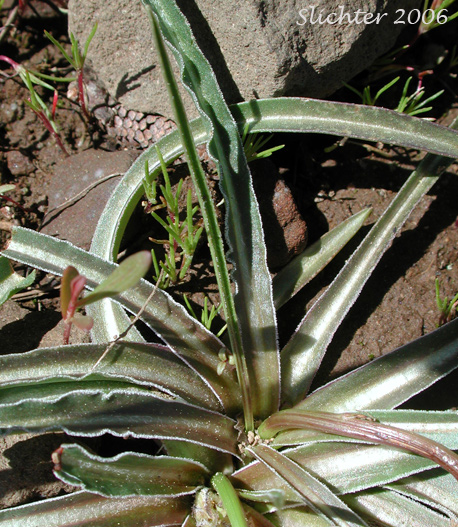
 The
photo at right shows the basal rosette of narrowly linear leaves of false agoseris.
The leaves measure up to 10-30 cm long and are typically less than 1 cm wide.
They tend to be 20-50 times as long as wide. Note the entire but sometimes wavy
margins and whitish edge, so distinctive of this species. Occasionally, a tooth
or two may be found along the margins. Photographed on the ridge dividing the
Dairy Creek and Cougar Creek drainages on the southeastern slopes of Mt. Adams...........May
29, 2006.
The
photo at right shows the basal rosette of narrowly linear leaves of false agoseris.
The leaves measure up to 10-30 cm long and are typically less than 1 cm wide.
They tend to be 20-50 times as long as wide. Note the entire but sometimes wavy
margins and whitish edge, so distinctive of this species. Occasionally, a tooth
or two may be found along the margins. Photographed on the ridge dividing the
Dairy Creek and Cougar Creek drainages on the southeastern slopes of Mt. Adams...........May
29, 2006.
False agoseris is a perennial wildflower arising 30 cm in height from a stout taproot. The crowded basal leaves and leafless stems range from nearly glabrous to covered with numerous fine, short hairs that are curly or crinkly. The numerous, attractive leaves are basal. They are narrow (to 1 cm wide) and up to 40 cm long, and linear to linear-lanceolate in shape. The margins are often crisped or wavy, and often with a thin white striping along the edge. The scapes are solitary to several, arising from the center of the basal rosette of leaves. The sap is milky.
The flower heads are dandelion-like with a narrow, bell-shaped involucre. The bracts are a little less than equal in size, lanceolate to linear-lanceolate in shape, with the upper end tapering gradually to a point. The bracts range from 17-20 mm long and typically have a dark midrib, and may have lighter striping on both sides of this midrib. The bracts are usually covered with white, woolly hairs, at least when young. The showy rays are bright yellow and number 13 or more. They open early in the morning and usually close by midday. Disk flowers are not present. The fruiting head is dandelion-like. The achenes measure 7-8 mm long and are spindle-shaped. The white pappus is about equal in length to the achene and bears 20-25 narrow bracts or chaffy scales that taper into the barbellate awn.
False agoseris is found in dry open places in the lowlands and into the foothills. It grows on sandy to rocky soils within its range and is one of the first plants to bloom in the spring in the habitats it is found in.
Microseris troximoides may be found east of the Cascades from southern British Columbia south through central Washington and Oregon to northern California, and eastward to western Montana and northern Utah.